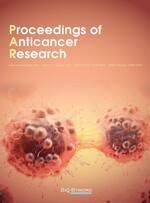Abstract
Objective: To explore the value of circulating free (cfDNA) content in the clinical diagnosis and treatment of triple-negative breast cancer (TNBC). Methods: A total of 39 TNBC patients, 45 non-TNBC patients, and 50 healthy individuals admitted to the Baoding First Central Hospital during 2019–2022 were recruited. The clinical data, peripheral blood cfDNA concentration, and clinicopathological indicators of the patients were observed and analyzed. Results: The difference in clinical indicators such as age, age range, tumor size, clinical stage, and lymph node metastasis between patients with TNBC and non-TNBC was insignificant (P > 0.05). The cfDNA concentrations (ng/mL) of the TNBC group, non-TNBC group, and healthy group were 24.12 ± 4.98, 15.36 ± 4.12, and 3.12 ± 1.02, respectively, and they are statistically different (P < 0.05). The difference in cfDNA concentration was insignificant between TNBC patients with tumors ≤ 2 cm and > 2 cm (P > 0.05) but was significant between TNBC patients with clinical stages I+II and III+IV (P < 0.05). The cfDNA concentration in TNBC patients with lymph node metastasis was significantly higher than those without lymph node metastasis (P < 0.05). Conclusion: cfDNA has an important application value in the diagnosis and treatment of breast cancer. By detecting the cfDNA level and its gene variation, valuable information about the progress and treatment effects of breast cancer can be obtained. This non-invasive detection method has a wide range of applications and can be used for early screening, auxiliary diagnosis, efficacy evaluation, and recurrence monitoring of breast cancer.
References
Wang Z, Yang L, Huang Y, et al, 2023, Analysis of MutT Homologous Protein 1 Gene Status and Immunotherapy Efficacy and Prognosis in Patients With Triple-Negative Breast Cancer. Chinese Journal of Eugenics and Genetics, 31(6): 1162–1170.
Si G, Shan C, 2023, Research Progress of Exosomal Non-Coding RNA in Triple-Negative Breast Cancer. Journal of Shandong First Medical University (Shandong Academy of Medical Sciences), 44(6): 461–465.
Tao Y, Zhang L, Chen D, 2023, Expression of AR in ER-Positive and Negative Breast Cancer And Its Clinical Significance. Journal of Practical Cancer, 38(6): 879–881 + 887.
Shan S, Wang H, Wang F, et al, 2023, The Predictive Value of NLR Combined With Serum CA15-3, NGF, and BSP for Postoperative Bone Metastasis in Patients with Triple-Negative Breast Cancer. Laboratory Medicine and Clinic, 20(10): 1369–1373.
Yang K, 2023, Factors Influencing the Prognosis of Triple-Negative Breast Cancer. Chinese Contemporary Medicine, 30(2): 109–113.
Xiao H, Zhang L, Gu L, 2022, Research Progress of CDK4/6 Inhibitors in Neoadjuvant Therapy of HR-Positive/HER2-Negative Breast Cancer. Tumor, 42(12): 835–844.
Yang F, Wang L, Liu Y, et al, 2017, Study on the Clinical Value of Peripheral Blood cfDNA and Long Fragment DNA Concentration in Patients With Breast Cancer. Clinical Medicine Literature, 4(94): 18497–18498.
Yi Z, Ma F, Yuan L, et al, 2017, Clinical Analysis of Circulating Tumor DNA in Predicting Resistance to Endocrine Therapy in Patients with Hormone Receptor-Positive Advanced Breast Cancer. Chinese Journal of Breast Diseases (Electronic Edition), 11(3): 132–137.
Cheng Z, Xu W, Chen Y, 2020, Comparison of the Application Value of Combined Detection of Blood CTCs and cfDNA and Traditional Tumor Marker Detection in Auxiliary Diagnosis of Breast Cancer. Journal of Clinical and Experimental Medicine, 19(9): 994–997.
Wang C, Wang Z, Jiang Q, 2022, Observation on the Curative Effect of TX, GX, NX Regimens in the Treatment of Advanced Triple-Negative Breast Cancer and Its Impact on the Long-Term Prognosis of Patients. Journal of Hunan Normal University (Medical Edition), 19(3): 149–151.
Fan X, Fu J, Liu J, 2021, Application of Detection of Circulating Tumor Cells and Circulating Free DNA in Peripheral Blood in Patients with Breast Cancer. Journal of Diagnostic Pathology, 1(28): 47–54.
Chang L, Yang D, Liu D, 2020, Application of Blood CTCs and cfDNA Detection in Breast Cancer. Journal of Molecular Diagnosis and Therapy, 12(10): 1298–1302.
Liu Z, 2020, Effect Analysis of Immunohistochemical Detection in Pathological Diagnosis of Breast Cancer. China Practical Medicine, 15(23): 4–7.
Ghoncheh M, Pournamdar Z, Salehiniya H, 2016, Incidence and Mortality and Epidemiology of Breast Cancer in the World. Asian Pacific Journal of Cancer Prevention, 17: 43–46. https://doi.org/10.7314/apjcp.2016.17.s3.43
Ferlay J, Soerjomataram I, Dikshit R, et al, 2015, Cancer Incidence and Mortality Worldwide: Sources, Methods and Major Patterns in GLOBOCAN 2012. International Journal of Cancer, 136: E359–E386. https://doi.org/10.1002/ijc.29210
